
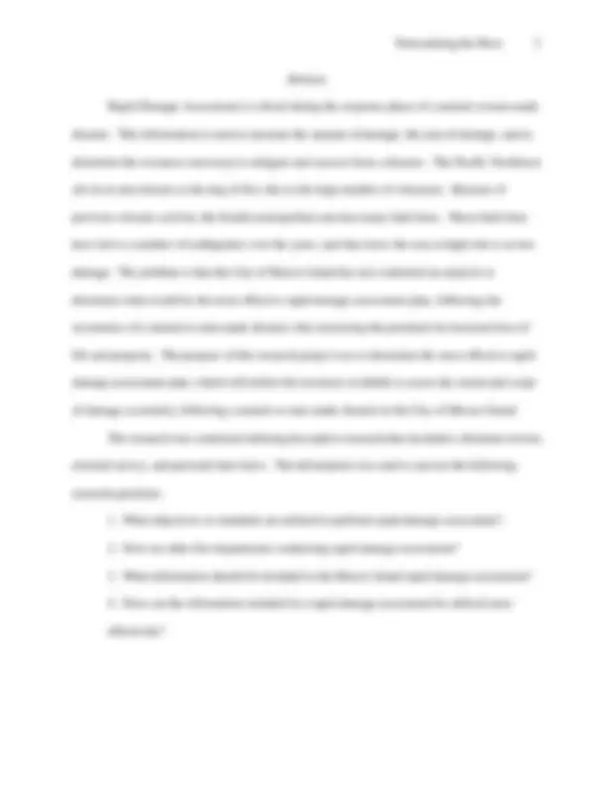

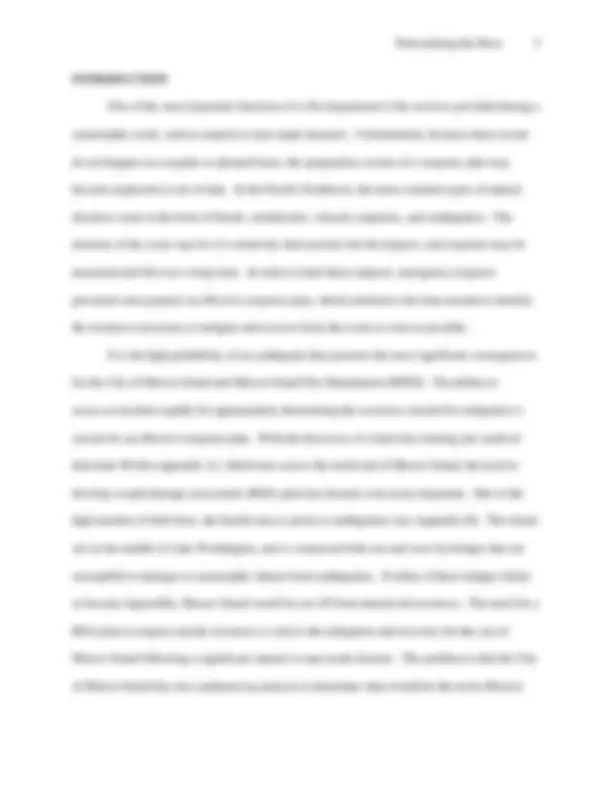
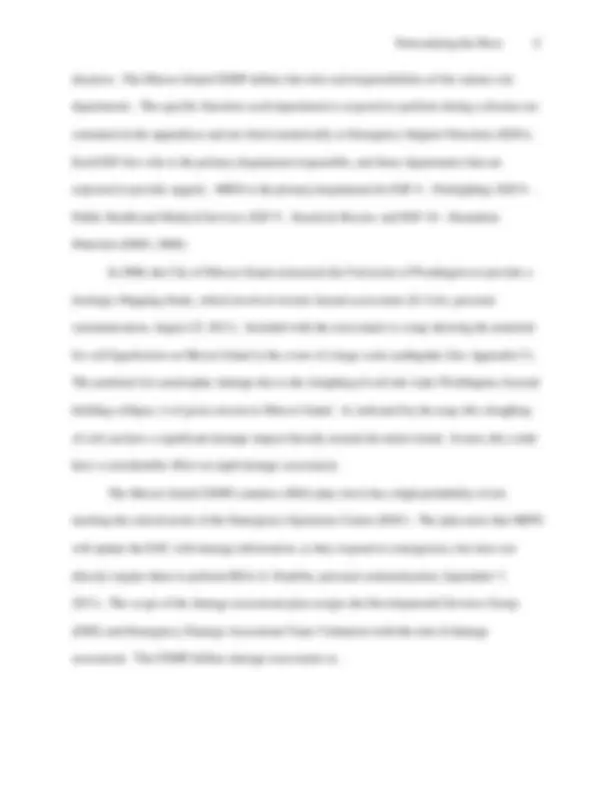
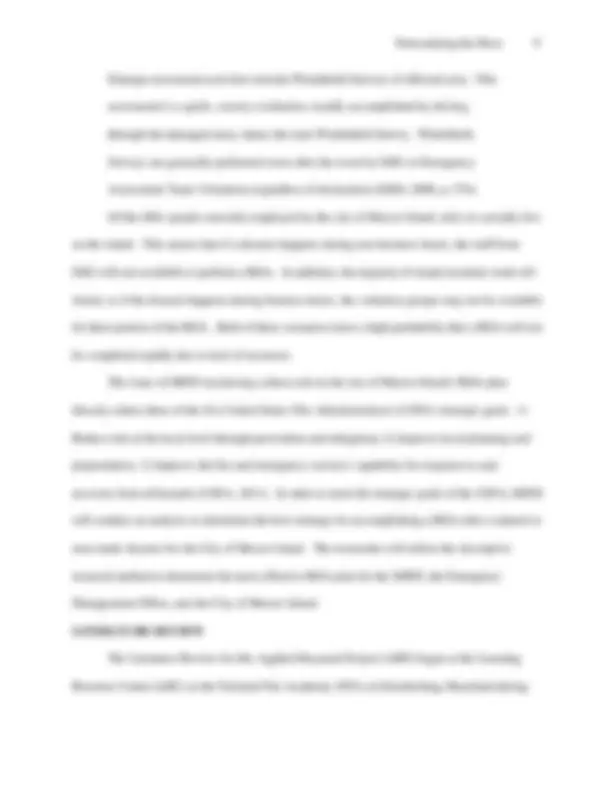
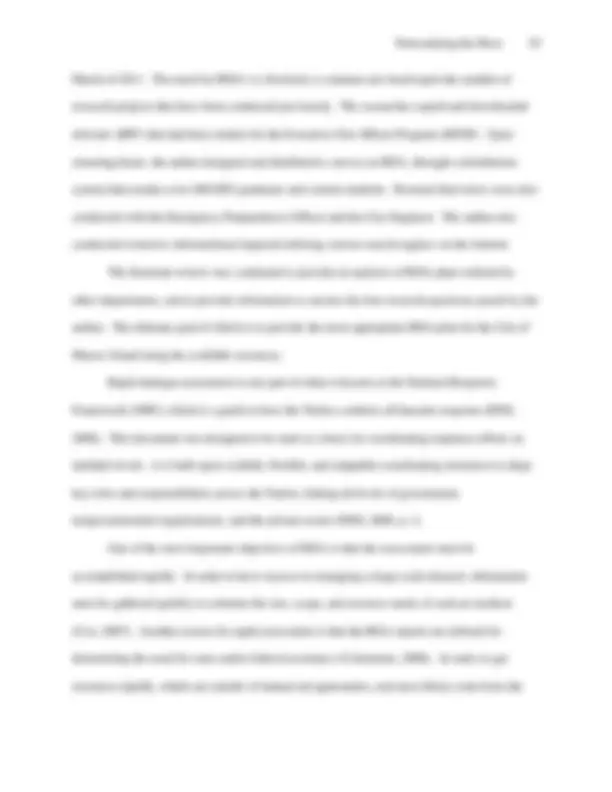
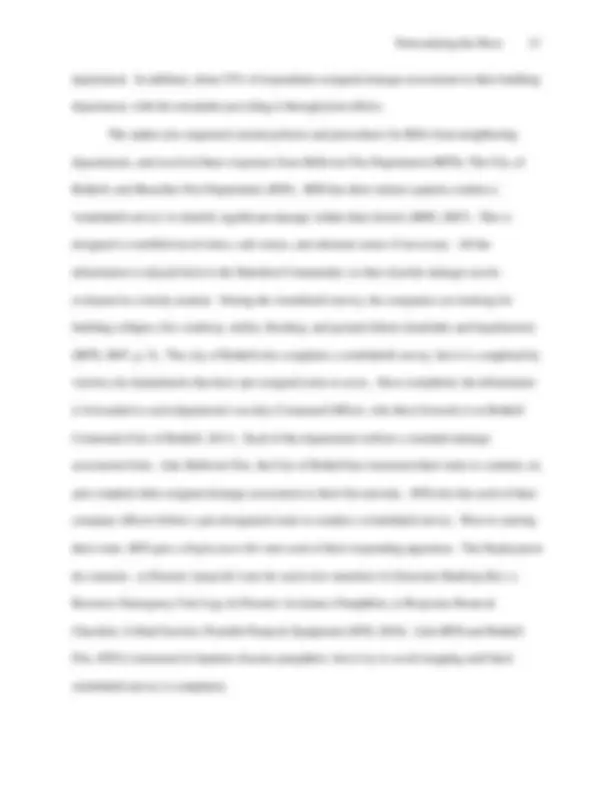
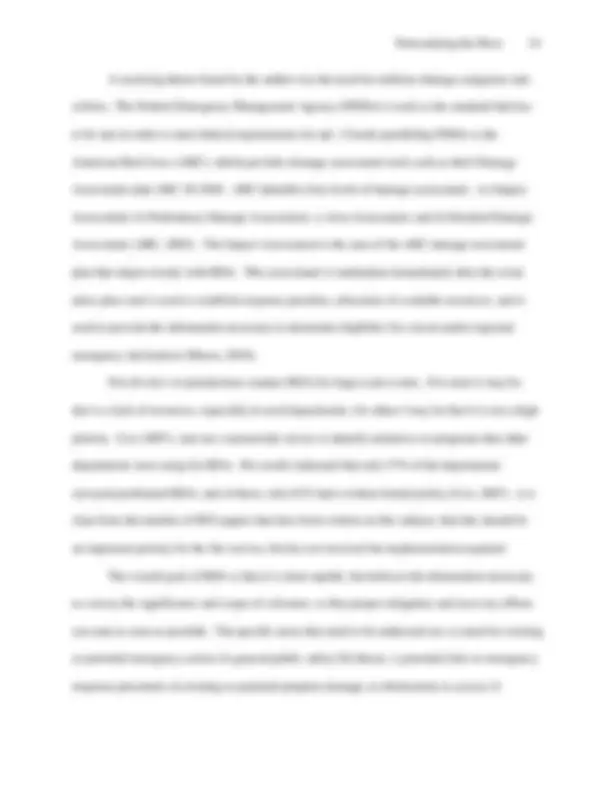

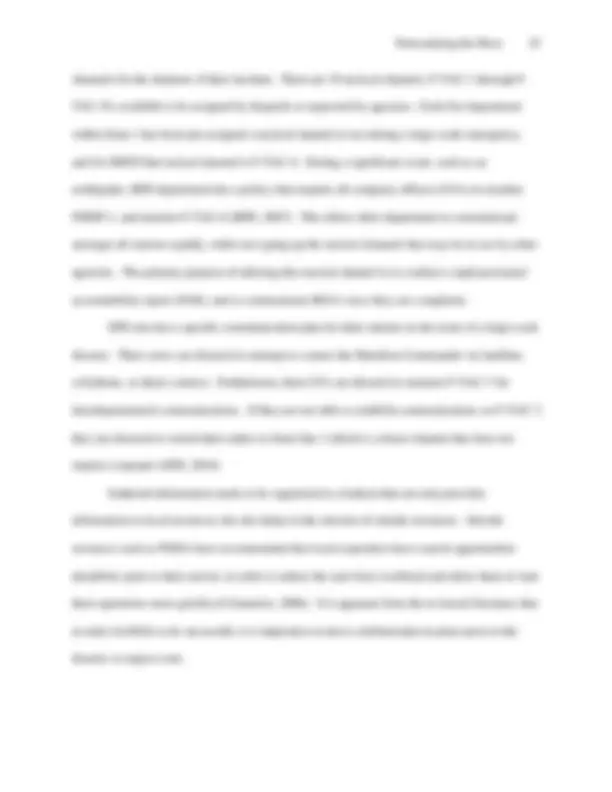
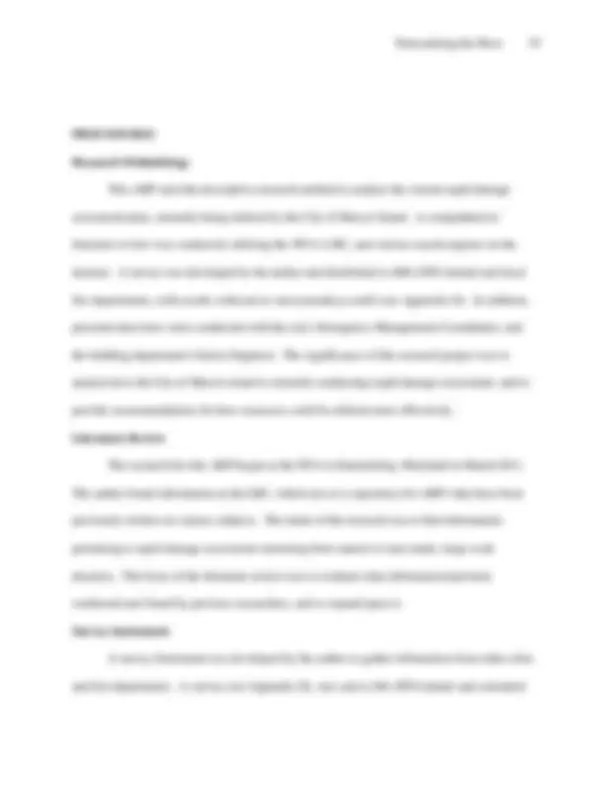

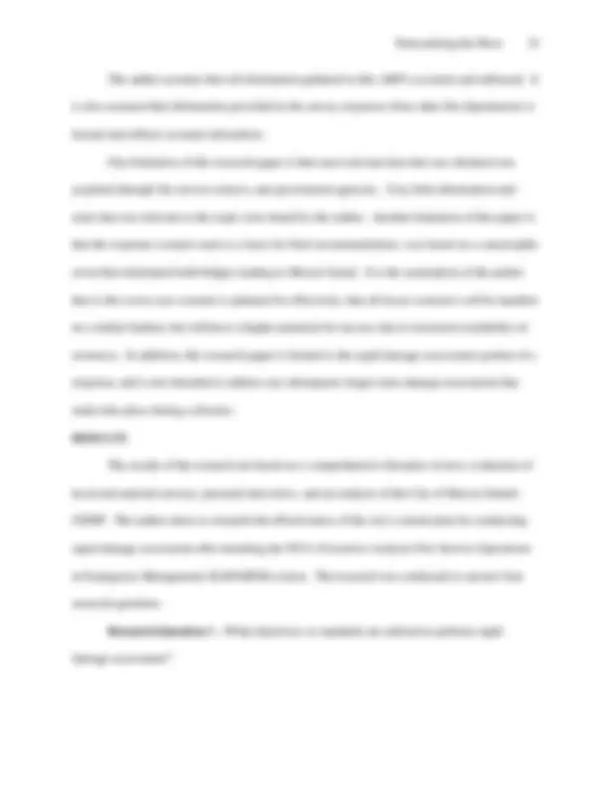
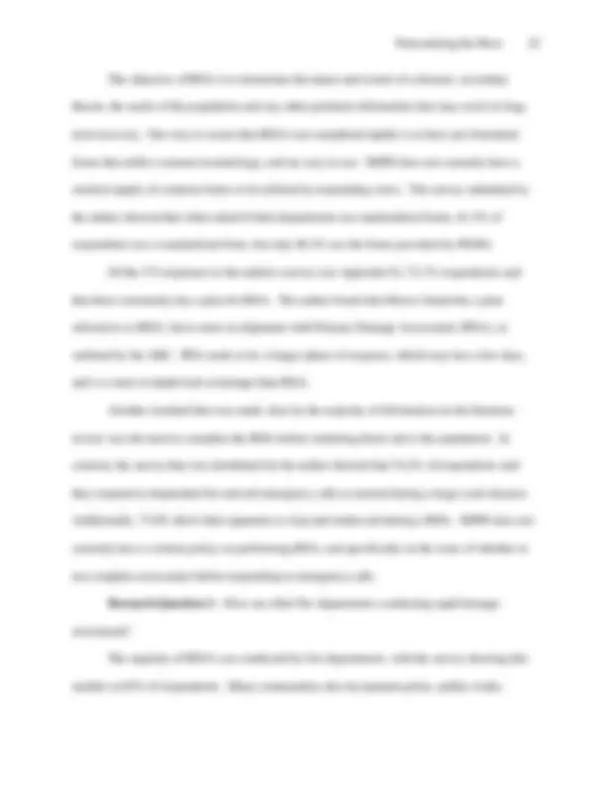
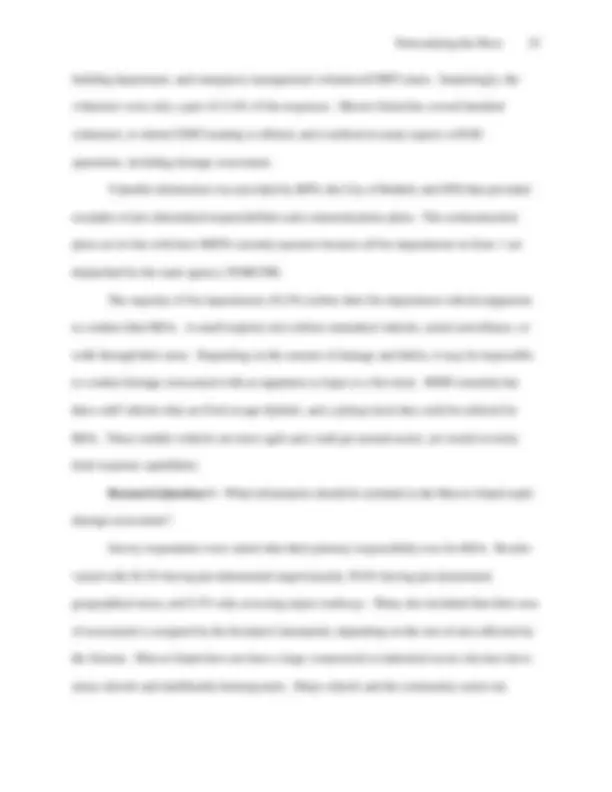
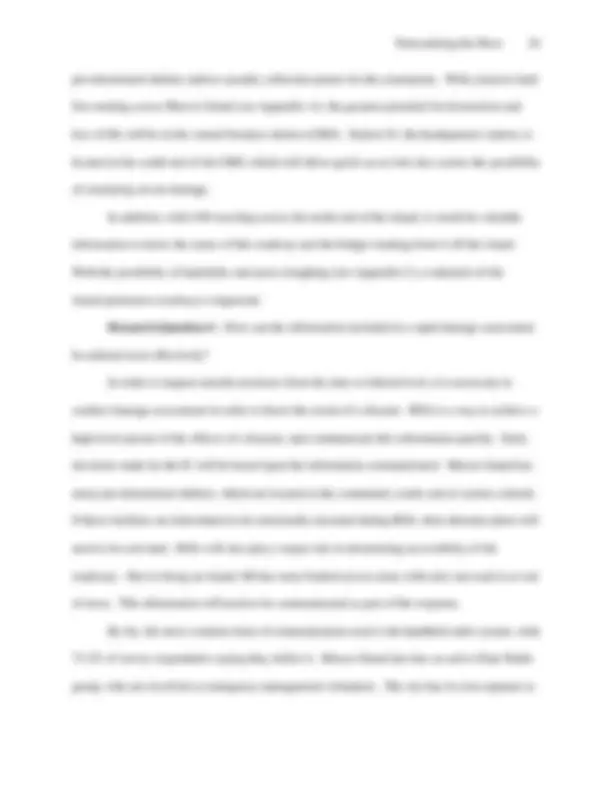
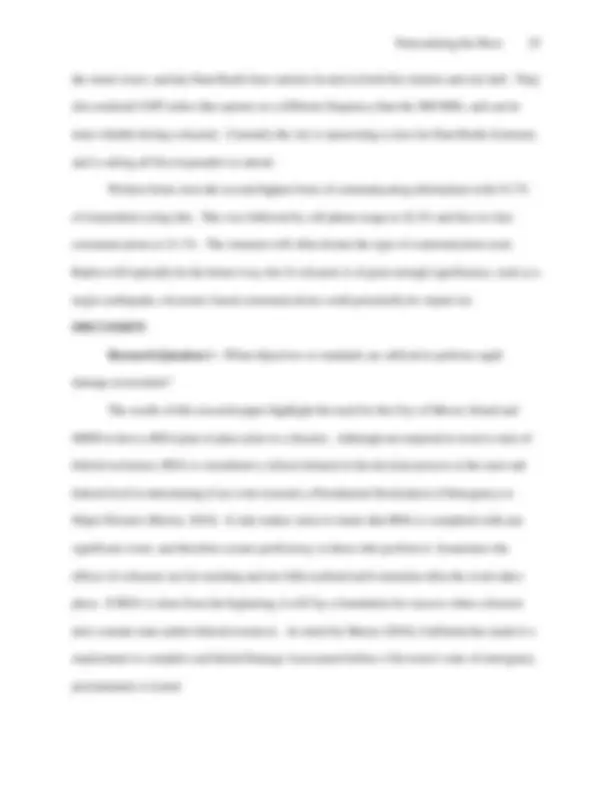
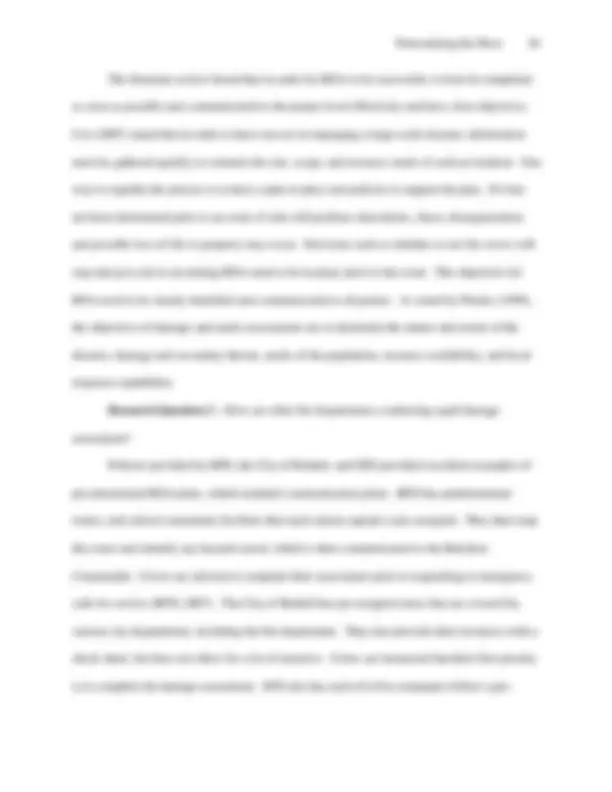
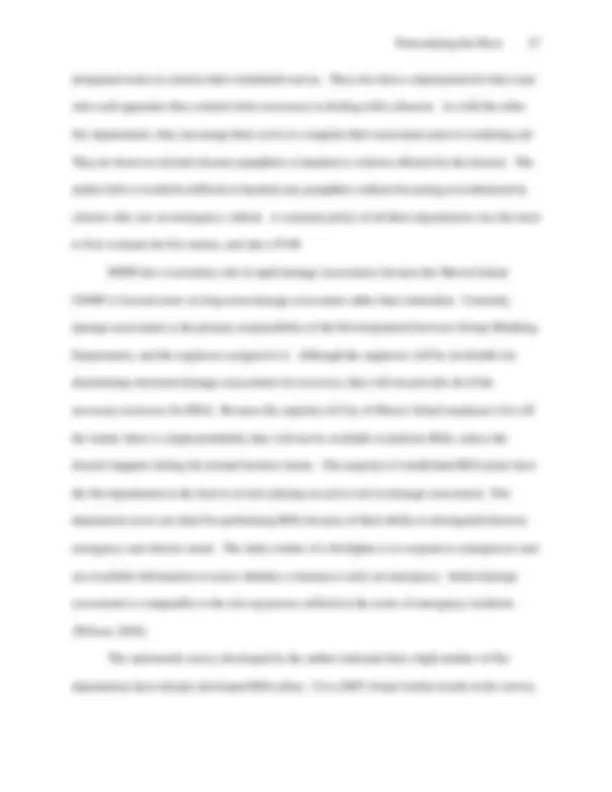
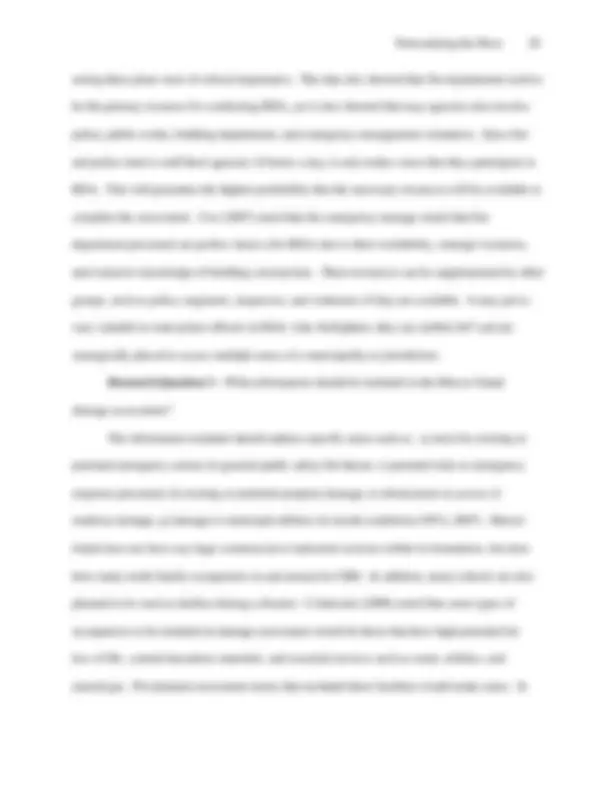
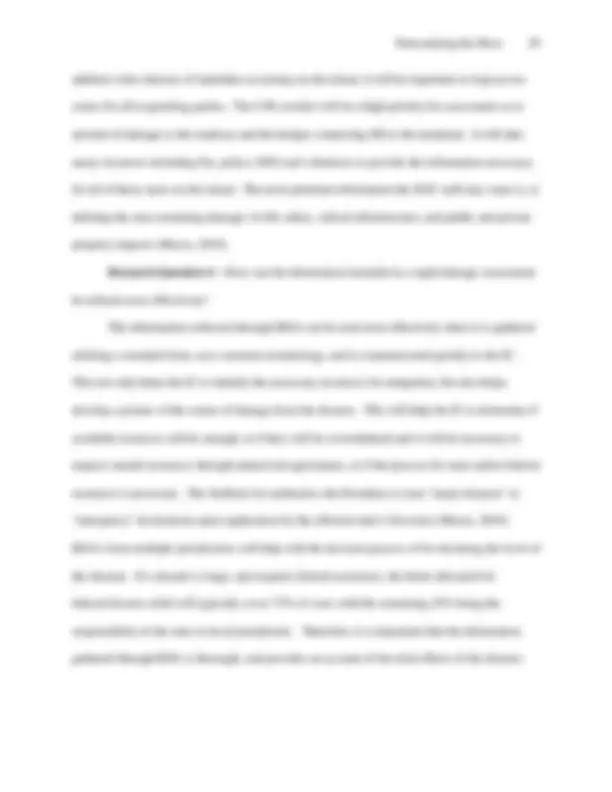
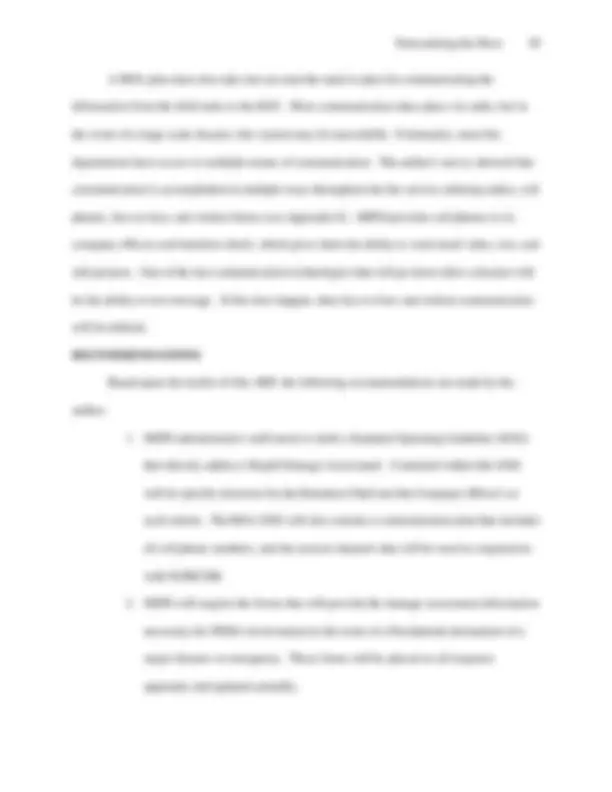
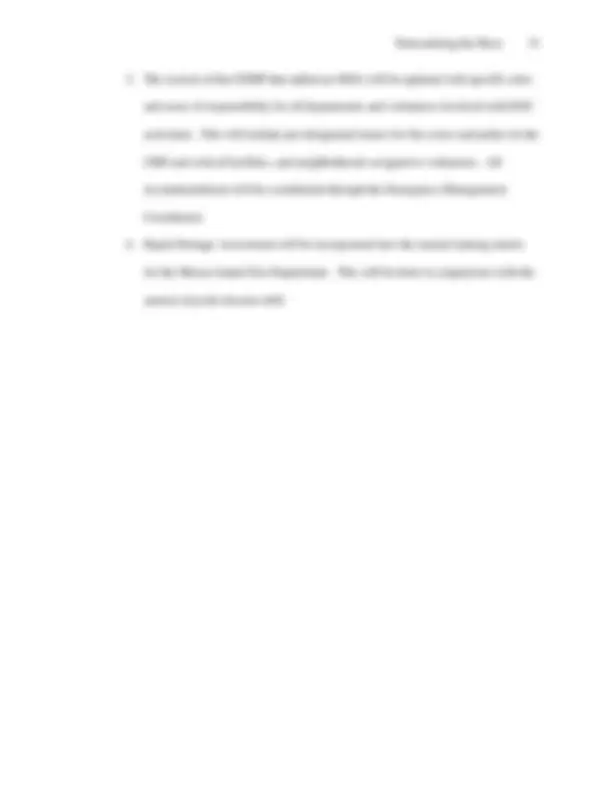
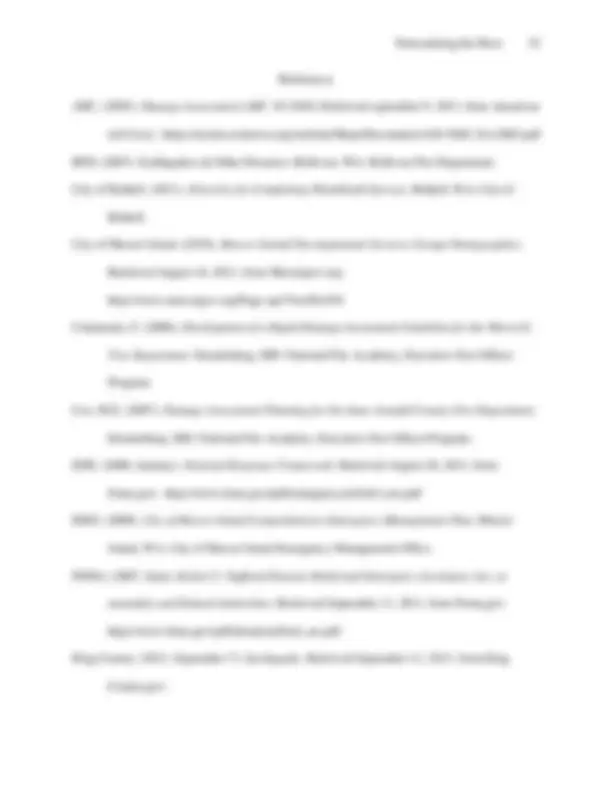

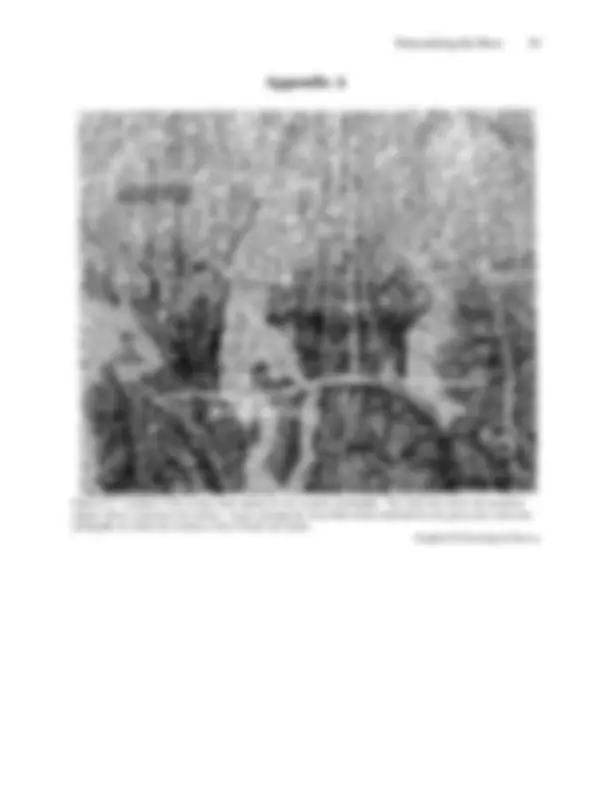

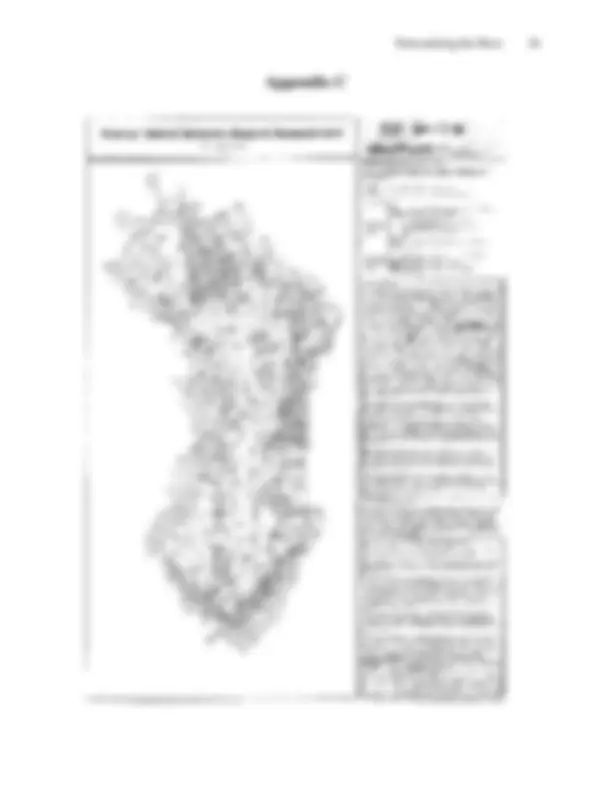
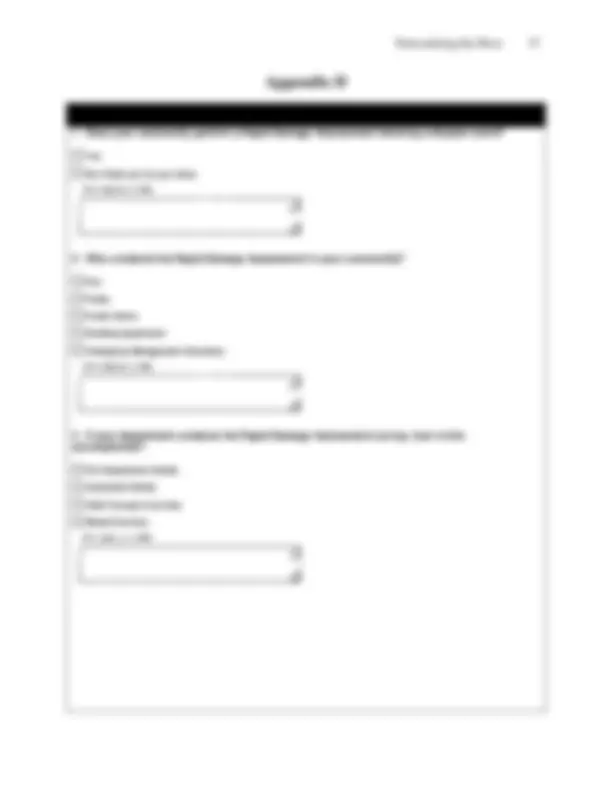


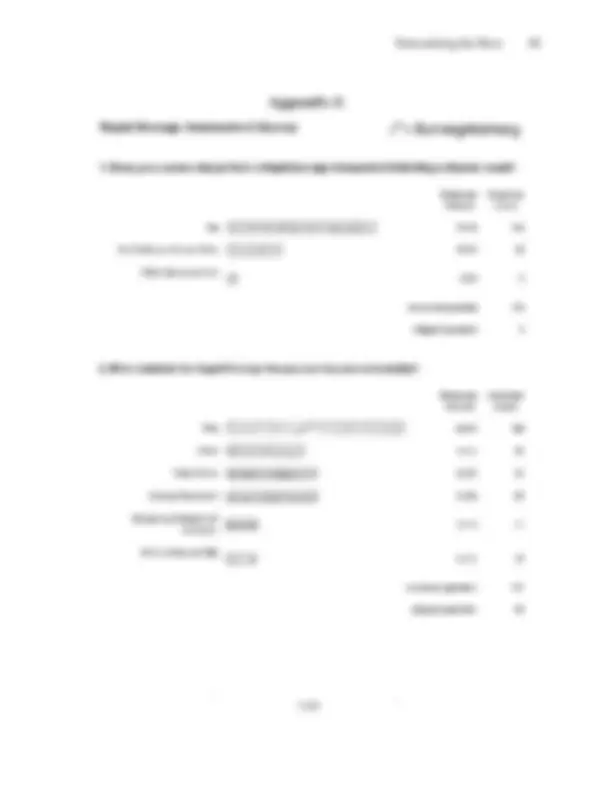
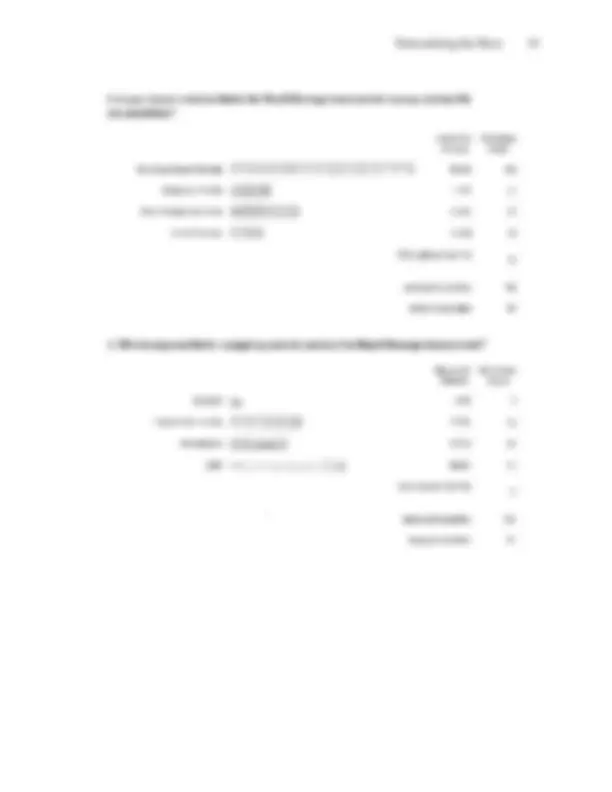
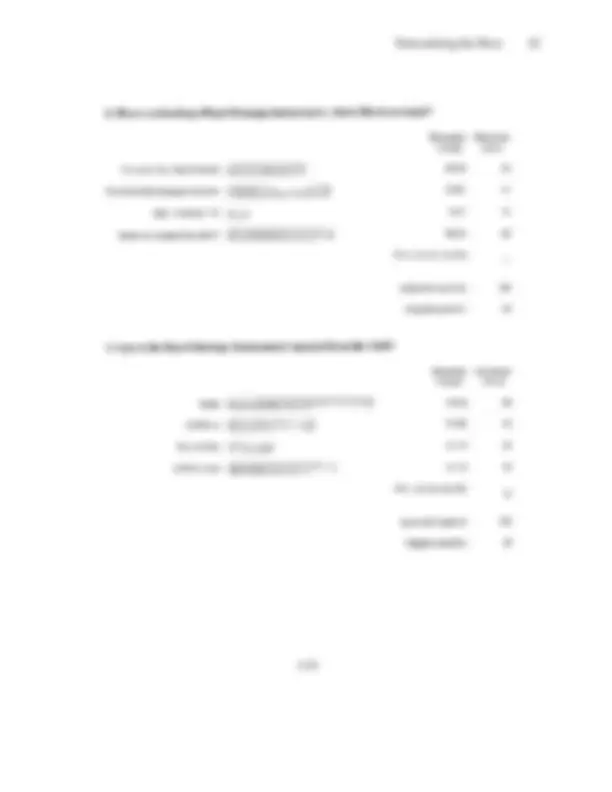
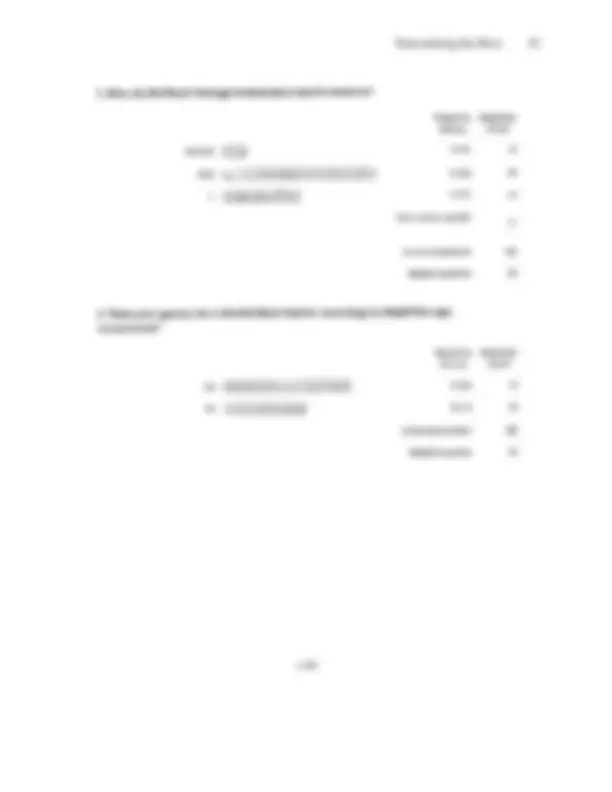
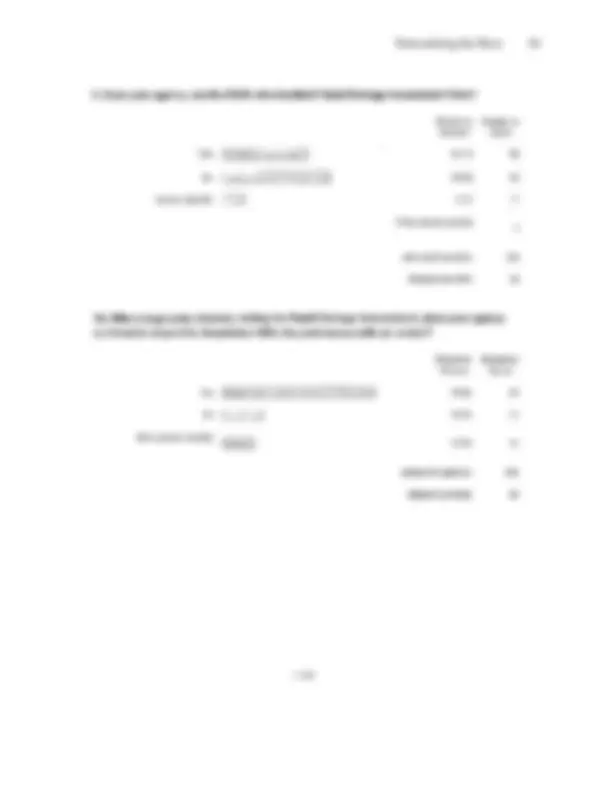



Study with the several resources on Docsity

Earn points by helping other students or get them with a premium plan


Prepare for your exams
Study with the several resources on Docsity

Earn points to download
Earn points by helping other students or get them with a premium plan
Community
Ask the community for help and clear up your study doubts
Discover the best universities in your country according to Docsity users
Free resources
Download our free guides on studying techniques, anxiety management strategies, and thesis advice from Docsity tutors
The importance of having an effective Rapid Damage Assessment (RDA) plan in place for the City of Mercer Island, Washington, following a natural or man-made disaster. The research project aims to determine the most effective RDA plan by examining objectives, standards, and practices of other fire departments. The document also discusses the potential impact of a significant earthquake on Mercer Island and the roles and responsibilities of various organizations in the RDA process.
What you will learn
Typology: Summaries
1 / 45

This page cannot be seen from the preview
Don't miss anything!






































Determining the Most Effective Rapid Damage Assessment Plan For the City of Mercer Island Steve Heitman Mercer Island Fire Department, Mercer Island, Washington
Certification Statement I hereby certify that this paper constitutes my own product, there where the language of others is set forth, quotation marks so indicate, and that the appropriate credit is given where I have used the language, ideas, expressions, or writings of another.
Signed:
One of the most important functions of a fire department is the services provided during a catastrophic event, such as natural or man-made disasters. Unfortunately, because these events do not happen on a regular or planned basis, the preparation section of a response plan may become neglected or out of date. In the Pacific Northwest, the most common types of natural disasters come in the form of floods, windstorms, volcanic eruptions, and earthquakes. The duration of the event may be of a relatively short period, but the impacts, and response may be measured and felt over a long time. In order to limit these impacts, emergency response personnel must prepare an effective response plan, which minimizes the time needed to identify the resources necessary to mitigate and recover from the event as soon as possible. It is the high probability of an earthquake that presents the most significant consequences for the City of Mercer Island and Mercer Island Fire Department (MIFD). The ability to assess an incident rapidly for appropriately determining the resources needed for mitigation is crucial for an effective response plan. With the discovery of a fault line running just south of Interstate 90 (See appendix A), which runs across the north end of Mercer Island, the need to develop a rapid damage assessment (RDA) plan has become even more important. Due to the high number of fault lines, the Seattle area is prone to earthquakes (see Appendix B). The island sits in the middle of Lake Washington, and is connected both east and west by bridges that are susceptible to damage or catastrophic failure from earthquakes. If either of these bridges failed or became impassible, Mercer Island would be cut off from mutual aid resources. The need for a RDA plan to request outside resources is vital to the mitigation and recovery for the city of Mercer Island following a significant natural or man-made disaster. The problem is that the City of Mercer Island has not conducted an analysis to determine what would be the most effective
The MIFD currently employs 31 full-time employees, with three administrative staff and 28 firefighters that are assigned to one of three platoons. Each platoon has nine members that include a battalion chief, two lieutenants, and six firefighters. The on-duty firefighters staff two stations each day (Station 91 & 92), with one located north end of the island and the other positioned at the south. The city council has chosen to staff the fire department on a daily basis with a minimum staffing level of seven line personnel. Each day the two fire stations on Mercer Island are staffed b a watch commander, and three-person engine/aid company at each station that consists of a company officer and two firefighters. On average, MIFD responds to 2300+ calls for service annually. Because there are only seven on-duty personnel at any given time, MIFD relies heavily on mutual aid agreements with neighboring departments for larger scale incidents. These mutual aid agreements are designed to provide the necessary resources and personnel for mitigating larger emergency events. These resources have to come from stations/cities that access Mercer Island via the I-90 bridges. This geographical challenge can cause some of these resources to be delayed from the measurement of response time criteria. Because of this, all MIFD firefighters train to the operations level in many of the technical rescue disciplines that would be necessary during a catastrophic event. In additions, at least two firefighters are trained to the technician level, so that a minimum rescue response can be accomplished with on-duty personnel. The Revised Code of Washington (RCW), Title 38, chapter 38.52, section 38.2. authorizes and directs the State Office of Emergency Management and all political subdivisions of the state to develop and maintain a Comprehensive Emergency Management Plan (CEMP) (RCW, 2010). These plans are developed to provide a framework for the various agencies within local, county, and state government to respond, mitigate, and recover from large-scale
disasters. The Mercer Island CEMP defines the roles and responsibilities of the various city departments. The specific functions each department is expected to perform during a disaster are contained in the appendices and are listed numerically as Emergency Support Functions (ESFs). Each ESF lists who is the primary department responsible, and those departments that are expected to provide support. MIFD is the primary department for ESF 4 – Firefighting; ESF 8 – Public Health and Medical Services; ESF 9 – Search & Rescue; and ESF 10 – Hazardous Materials (EMO, 2008). In 2008, the City of Mercer Island contracted the University of Washington to provide a Geologic Mapping Study, which involved seismic hazard assessment (D. Cole, personal communication, August 25, 2011). Included with the assessment is a map showing the potential for soil liquefaction on Mercer Island in the event of a large-scale earthquake (See Appendix C). The potential for catastrophic damage due to the sloughing of soil into Lake Washington, beyond building collapse, is of great concern to Mercer Island. As indicated by the map, this sloughing of soil can have a significant damage impact literally around the entire island. In turn, this could have a considerable effect on rapid damage assessment. The Mercer Island CEMP contains a RDA plan, but it has a high probability of not meeting the critical needs of the Emergency Operations Center (EOC). The plan notes that MIFD will update the EOC with damage information, as they respond to emergencies, but does not directly require them to perform RDA (J. Franklin, personal communication, September 7, 2011). The scope of the damage assessment plan assigns the Developmental Services Group (DSG) and Emergency Damage Assessment Team Volunteers with the task of damage assessment. The CEMP defines damage assessment as:
March of 2011. The need for RDA's is obviously a common one based upon the number of research projects that have been conducted previously. The researcher copied and downloaded relevant ARP's that had been written for the Executive Fire Officer Program (EFOP). Upon returning home, the author designed and distributed a survey on RDA, through a distribution system that reaches over 600 EFO graduates and current students. Personal Interviews were also conducted with the Emergency Preparedness Officer and the City Engineer. The author also conducted extensive informational inquired utilizing various search engines on the internet. The literature review was conducted to provide an analysis of RDA plans utilized by other departments, and to provide information to answer the four research questions posed by the author. The ultimate goal of which is to provide the most appropriate RDA plan for the City of Mercer Island using the available resources. Rapid damage assessment is one part of what is known as the National Response Framework (NRF), which is a guide to how the Nation conducts all-hazards response (DHS, 2008). This document was designed to be used as a basis for coordinating response efforts on multiple levels. it is built upon scalable, flexible, and adaptable coordinating structures to align key roles and responsibilities across the Nation, linking all levels of government, nongovernmental organizations, and the private sector (DHS, 2008, p. i). One of the most important objectives of RDA is that the assessment must be accomplished rapidly. In order to have success in managing a large-scale disaster, information must be gathered quickly to estimate the size, scope, and resource needs of such an incident (Cox, 2007). Another reason for rapid assessment is that the RDA reports are utilized for determining the need for state and/or federal assistance (Colantonio, 2006). In order to get resources rapidly, which are outside of mutual aid agreements, and most likely come from the
state or federal level, it is essential that RDA's are completed quickly and thoroughly. One way to help with the effectiveness is to have pre-formatted forms to gather the information (Colantonio, 2006). There are many other objectives associated with rapid damage assessment. Plantiz (1999) notes that: The objectives of damage and needs assessments are to determine the nature and extent of the disaster, damage and secondary threats, needs of the population, resource availability and local response capacity, options for relief assistance, longer-term recovery and development, and needs for international assistance (p. 2). The needs of the entire population are a part of RDA and may need to be taken into account by having written standards. This may cause the need(s) of the individual to be ignored at the start of an event response, due to the necessity of completing the RDA and relaying pertinent information to the EOC. For some, this may cause an ethical dilemma that would be addressed best prior to an event. According to Russell (2010) for RDA to be successful, it may be necessary to pass by businesses or individuals that are in need of help. This could result in fire crews driving by individuals who are in need of aid. Bellevue Fire (2007) states in their policy, "In order to complete an initial reconnaissance in a timely manner, a Company may need to bypass fires, collapsed buildings, and other ongoing emergencies" (p. 5). If you do not have a predetermined plan prior to the event, it is almost impossible to complete a coordinated, comprehensive, and timely search of an area (Colantonio, 2006). In order for RDA's to be effective in acquiring resources, they should follow certain standards to ensure successful implementation. According to Planitz (1999), the information
department. In addition, about 35% of respondents assigned damage assessment to their building department, with the remainder providing it through joint efforts. The author also requested current policies and procedures for RDA from neighboring departments, and received three responses from Bellevue Fire Department (BFD), The City of Bothell, and Shoreline Fire Department (SFD). BFD has their station captains conduct a 'windshield survey' to identify significant damage within their district (BFD, 2007). This is designed to establish travel times, safe routes, and alternate routes if necessary. All the information is relayed back to the Battalion Commander, so that citywide damage can be evaluated in a timely manner. During the windshield survey, the companies are looking for building collapse, fire, roadway, utility, flooding, and ground failure (landslide and liquefaction) (BFD, 2007, p. 5), The city of Bothell also completes a windshield survey, but it is completed by various city departments that have pre-assigned areas to asses. Once completed, the information is forwarded to each department's on-duty Command Officer, who then forwards it on Bothell Command (City of Bothell, 2011). Each of the departments utilizes a standard damage assessment form. Like Bellevue Fire, the City of Bothell has instructed their units to continue on, and complete their assigned damage assessment as their first priority. SFD also has each of their company officers follow a pre-designated route to conduct a windshield survey. Prior to starting their route, SFD puts a Deployment Kit onto each of their responding apparatus. The Deployment kit contains: a) Disaster 'jump kit' (one for each crew member); b) Structure Marking Kit; c) Resource Emergency Unit Log; d) Disaster Assistance Pamphlets; e) Response Route & Checklist; f) Hard Suction, Portable Pump & Equipment (SFD, 2010). Like BFD and Bothell Fire, SFD is instructed to handout disaster pamphlets, but to try to avoid stopping until their windshield survey is completed.
A recurring theme found by the author was the need for uniform damage categories and criteria. The Federal Emergency Management Agency (FEMA) is used as the standard that has to be met in order to meet federal requirements for aid. Closely paralleling FEMA is the American Red Cross (ARC), which provides damage assessment tools such as their Damage Assessment plan ARC 30-3049. ARC identifies four levels of damage assessment: A) Impact Assessment; b) Preliminary Damage Assessment; c) Area Assessment; and d) Detailed Damage Assessment (ARC, 2003). The Impact Assessment is the area of the ARC damage assessment plan that aligns closely with RDA. This assessment is undertaken immediately after the event takes place and is used to establish response priorities, allocation of available resources, and is used to provide the information necessary to determine eligibility for a local and/or regional emergency declaration (Mazza, 2010). Not all city's or jurisdictions conduct RDA for large-scale events. For some it may be due to a lack of resources, especially in rural departments, for others I may be that it is not a high priority. Cox (2007), sent out a nationwide survey to identify initiatives or programs that other departments were using for RDA. His results indicated that only 57% of the departments surveyed performed RDA, and of those, only 65% had a written formal policy (Cox, 2007). it is clear from the number of EFO papers that have been written on this subject, that this should be an important priority for the fire service, but has not received the implementation required. The overall goal of RDA is that it is done rapidly, but delivers the information necessary to convey the significance and scope of a disaster, so that proper mitigation and recovery efforts can start as soon as possible. The specific areas that need to be addressed are: a) need for existing or potential emergency action; b) general public safety life threat; c) potential risks to emergency response personnel; d) existing or potential property damage; e) obstructions to access; f)
managerial/technical/advisory services, and the allocation of funds from the Federal Disaster Relief Fund (Mazza, 2010). Federal disaster relief funds are allocated by FEMA, and typically provide 75% of the eligible reimbursement costs with the state or local jurisdiction covering the remaining 25%. The importance of the need for RDA cannot be over emphasized. Although not specifically required by the Stafford Act to receive federal disaster assistance, initial and preliminary damage assessments are considered critical elements of the decision process in determining whether an event warrants a Presidential Declaration of Emergency or Major Disaster (Mazza, 2010, pp. 33-34). Even though assigned resources have been able to collect the necessary information to properly mitigate and respond to a disaster, if they cannot effectively communicate it, the information will be useless. Therefore, it is essential that pre-planning take place so that the information gathered is reported to the EOC and disseminated appropriately. There is a variety o ways that this can take place. Russell (2010) reported survey results that showed 61% of respondents report their information via paper, 53% utilize radio transmission, 30% use cellular phones, and 29% communicate face-to-face. For fire service coverage, King County, WA is broken down into three geographical areas known as Zones, which are numbered 1, 3, and 5. MIFD is part of Zone 1, along with thirteen other fire departments and jurisdictions. The entire Zone, including police and fire, is dispatched through one agency respectively know as NORCOM. This model will provide a great asset for communication during a disaster, and will expedite communications on a regional level. This type of dispatch system is not common, and the author did not read any literature that referred to one of a similar nature. All fire emergency calls are dispatched to the various fire agencies on one channel known as FDISP-1. Fire agencies are then assigned to various tactical
Research Methodology This ARP used the descriptive research method to analyze the current rapid damage assessment plan, currently being utilized by the City of Mercer Island. A comprehensive literature review was conducted, utilizing the NFA's LRC, and various search engines on the internet. A survey was developed by the author and distributed to 680+ EFO alumni and local fire departments, with results collected at surveymonkey.com® (see Appendix D). In addition, personal interviews were conducted with the city's Emergency Management Coordinator, and the building department's Senior Engineer. The significance of this research project was to analyze how the City of Mercer island is currently conducting rapid damage assessment, and to provide recommendations for how resources could be utilized more effectively. Literature Review The research for this ARP began at the NFA in Emmitsburg, Maryland in March 2011. The author found information at the LRC, which acts as a repository for ARP's that have been previously written on various subjects. The intent of the research was to find information pertaining to rapid damage assessment stemming from natural or man-made, large-scale disasters. The focus of the literature review was to evaluate what information had been conducted and found by pervious researchers, and to expand upon it. Survey Instrument A survey Instrument was developed by the author to gather information from other cities and fire departments. A survey (see Appendix D), was sent to 80+ EFO alumni and contained
questions designed around how other fire department's are utilized for rapid damage assessment. Included in this were departments from the author's local area, which would provide valuable information on shared types of disasters for the Pacific Northwest. The author felt that a survey sent out to such a wide variety of departments, would provide a high and varied amount of feedback, with a higher percentage of responses. Personal Interviews/Communications Don Cole, Senior Engineer for the City of Mercer Island, provided data necessary to determine possible effects of an earthquake along the fault line that runs across Mercer Island. Mr. Cole was instrumental in providing background in relation to previous slide history throughout the history of Mercer Island. This information included the fact that there is currently what is referred to as an underwater forest on the east side of Mercer Island. This is due to a pervious sloughing of material where literally the whole hillside slid under the surface of lake Washington, but all of the trees within the affected area are still upright (D. Cole, personal interview, August 25, 2011). Mr. Cole also provided valuable insight into reading the map associated with the UW study, which included areas of likely soil liquefaction. Jennifer Franklin, Emergency Management Coordinator, and a sworn Police Officer for the City of Mercer Island, provided valuable information regarding the city's CEMP. Officer Franklin also provided information for current city policy with regard to RDA, and the feedback to possible recommendations. She also supplied information about the city's volunteer groups, and their functions within the current CEMP. Assumptions and Limitations